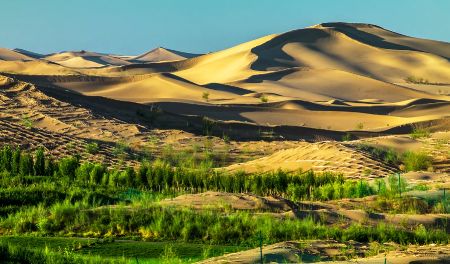by Larry
April, 2018Deserts and TreesThough controversy remains in various quarters about the cause, few deny we are in the midst of significant climate change, with average temperatures having risen enough to result in major melting in polar regions and a substantial reduction in glaciers and snowfall in mountainous areas around the globe. Less noted are increased desertification which has begun to affect many expanses, within the United States including especially CA, AZ, NM, and TX. Worldwide, deserts and desertification (the loss of fertile soil to desert through drought, poor agricultural practices, and deforestation) now affects 40% of the world's land mass. In Africa, deserts are expanding fast enough that in a dozen years it is projected only 33% of the region will be capable of producing crops. Yet desertification is affecting most continents, threatening the adequate feeding of populations in Mexico, India, China, and Indonesia, among others. Enough loss of arable land is occurring that continued availability of sufficient food stocks for a growing human population is at risk. Hunger and famine are on the rise. More than 20,000,000 are in danger of starving to death, the worst malnutrition crisis since World War II. For those not affected, this may seem a low figure compared with the total humans on the sphere today. In fact, severe malnutrition verging on and including starvation are considered far worse, affecting nearly one billion worldwide. Unless there are rapid changes, the trend could be dire. We may have passed the point of a sustainable number of people on the planet.
Faced with the growing hazard, concerned experts are seeking solutions. One suggested area of promise is to plant millions of trees in buffer areas on the edges of regions that have already converted to desert. There are pro and con arguments. Trees take awhile to germinate, grow, and mature. If they are to help, the efforts will need to commence and big time. Millions or, better, billions of trees would be needed. If this is not done or is insufficient, we may look for malnutrition and starvation numbers to begin spiking on an unprecedented scale in another decade or so. Once established, forests mitigate increases of carbon in the atmosphere, build up the soil, lower the needs for added water in an area, reduce harmful runoff, and have a generally cooling effect where they are thriving. Trees, though, normally require a lot of water and care, not inconsequential factors in the arid places where they are intended to be helpful and where local inhabitants are often poor, busy with other enterprises. Planting the numbers required within a short period of time is a big challenge in itself. The trees, once started, must still be adequately and regularly hydrated, protected from fires, and kept safe as well from poachers who might cut them down for building materials and fuel, or could try and use the area again for farming. The new trees also may have to be treated against insect infestations. In certain regions, ground water salinization is also a threat. One solution for the water problem is to plant trees such as baobab, mimosa, neem, willow, and acacia, already adapted to drier conditions. These trees, though usually not looking like the shade trees familiar to folks in more temperate climates and more spread out or isolated than in our typical concept of a forest, actually provide more cooling and total forest cover than previously thought. Areas between the trees themselves might be planted in hearty, drought-tolerant shrubs and grasses like maize (corn), chaya, and buffel grass. Other avenues for research into greater nutrition for our ever expanding population include hydroponics and roof-top gardens, useful as the majority of us now live in urban settings. As the problem of malnutrition gets worse, more remedies may have to be tried, in the hope that from many might come at least a few that offer sustainable, practical remedies. Meanwhile, one such possible remedy is materializing from the Gobi Desert. The Kubuqi Ecological Restoration Project in that region may inspire similar ways of dealing with desertification elsewhere. This is one of the first plans implemented to control and then begin to reverse desertification. It is, however, thus far only a qualified triumph. The project involves an integrated effort by the Chinese government, private industry, modern technology, and local farmers or ranchers to tame large land tracts among Manchuria's Gobi desert dunes and make them productive again. Begun in the 1980s, it involves the planting and tending by local people of both desert-hearty trees plus smaller plants, such as licorice, a paying crop, along with enhancing the conditions for raising and profiting from sheep. Unfortunately, this is not a panacea solution. Journalists have found that unless there is significant, ongoing tending of the trees and other plantings plus government attention to the circumstances in the project areas, they can quickly degenerate, and the desertification resumes. The record from the Kubuqi Project seems to indicate that even the best, long-term plans can go awry, so solving this issue on a global scale will be a formidable hurdle. |
